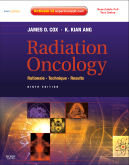|
|
|
| |
 |
|
|

|
 推薦指數:
推薦指數:





|
|
- 內容介紹
|
Radiation Oncology, 9th Edition - Rationale, Technique, Results
By James D. Cox, MD, FACR and Kie Kian Ang, MD, PhD
1088 pages
Trim size 8 3/4 X 11 1/16 in
Copyright 2010
Description
Radiation Oncology: Rationale, Technique, Results, by James D. Cox, MD and K. Kian Ang, MD, PhD, provides you with authoritative guidance on the latest methods for using radiotherapy to treat patients with cancer. Progressing from fundamental principles through specific treatment strategies for the cancers of each organ system, it also addresses the effects of radiation on normal structures and the avoidance of complications. This 9th edition covers the most recent indications and techniques in the field, including new developments in proton therapy and intensity-modulated radiotherapy (IMRT). It also features, for the first time, full-color images throughout the text to match those that you see in practice, and uses new color-coded treatment plans to make targets, structures, and doses easier to read at a glance. Evidence from randomized clinical trials is included whenever possible to validate clinical recommendations. The state-of-the-art coverage inside this trusted resource equips you to target cancer as effectively as possible while minimizing harm to healthy tissue.
Key Features
Stands apart as the only book in the field to cover the conceptual framework for the use of radiotherapy by describing the most effective techniques for treatment planning and delivery and presenting the results of each type of therapy.
Emphasizes clinical uses of radiation therapy, providing pertinent, easy-to-understand information on state-of-the-art treatments.
Includes information useful for non-radiotherapists, making it ''recommended reading'' for other oncology specialists.
Offers a practical, uniform chapter structure to expedite reference.
New to this Edition
Guides you through the use of the newest radiation oncology techniques, including principles of proton therapy and new developments in intensity-modulated radiotherapy (IMRT).
Incorporates evidence from randomized clinical trials whenever possible to validate clinical recommendations.
Presents full-color images throughout to match the images that you see in practice.
Uses new color-coded treatment plans to make targets, structures, and doses easier to read at a glance.
Extensive use of “combination” imaging presents a complete picture of how to more precisely locate and target the radiotherapy field.
|
|
|

